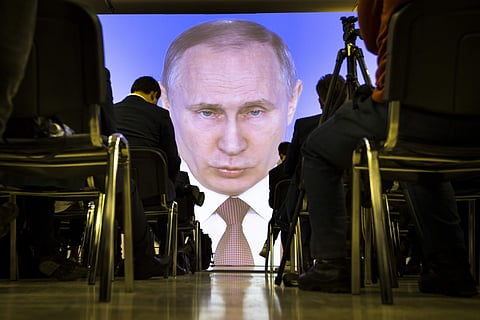

CHENNAI: Russian president Vladimir Putin’s recent claim that his country is close to deploying nuclear-propelled hypersonic cruise missiles that could render NATO’s anti-missile systems useless has the western world aghast. “We are developing new types of strategic weapons that do not use ballistic flight paths on the way to the target. This means that the missile defense systems are useless as a counter-means and just senseless,” Putin told his countrymen and the world during a state-of-the-nation speech in Moscow on Thursday.
Why the new weapons are called “revolutionary”?
Putin says Russia successfully tested cruise missiles and underwater drones that are propelled by nuclear reactors – a claim not yet verified. A missile powered by a nuclear reactor is indeed something new. No other country has it. What are its advantages? Well, unlike a ballistic missile, a nuclear powered missile would receive thrust for the entire length of its journey. This ensures it can travel at far greater speeds than a ballistic missile, which receives thrust only during the initial stage (what experts call the boost phase), when it lifts off from the earth’s surface. Once the ballistic missile reaches the outer space, the warhead or the payload separates from the core of the missile and flows freely (meaning, devoid of thrust) for the remainder of its journey to the target.
Also, since Putin’s new weapons are nuclear propelled, they could travel longer, like a nuclear submarine. Furthermore, unlike ballistic missiles, which follow a predictable path, hypersonic missiles like the one Russia claims to have made, could change course midway, making them nearly impossible to intercept.
So, theoretically speaking, Russia’s new missiles could travel much faster than any of the ballistic missiles in US’s possession, have unlimited range and follow an unpredictable path. Well, that’s a deadly combination indeed.
Should the US and allies be worried?
NATO countries have every reason to feel worried, if it turns out that Putin was indeed telling the truth. The ABMs, which Brussels has proudly deployed to protect its member states in Europe would be useless against such a weapon.
“We don't have effective defenses, so we are not prepared to deal with an attack," Barry Blechman, co-founder of the Stimson Center, Washington-based nonpartisan anti-nuclear proliferation think tank told the AFP news agency.
That’s bad for NATO. Just how bad? Well, so long as the US and allies don’t catch up, Russia would continue to enjoy a marked military advantage over them, assuming that the news weapon could be successfully deployed.
Since the beginning of the Cold War and the onset of nuclear arms race in 1950s, the US-made ABMs have been the key to the security of America’s European allies when Russia went on to build a huge arsenal of ballistic missiles. That security shield looks more or less impotent right now.
Why did Putin go for it?
Since the end of Cold War and more specifically after it withdrew from the 1972 Anti Ballistic Missile Treaty, the United States has been deploying ballistic missiles in East Europe at an alarming pace. Their deployment has, in theory, made Russia’s vast ballistic missile arsenal useless. So Moscow has every reason to feel upset. Putin has urged NATO more than once to reconsider deploying anti-missile systems close to the Russian borders. Every time, the United States responds saying they are aimed at Iran and not Russia.
On top of that, NATO’s eastward expansion, and the West’s interference in the internal affairs of former Soviet states, must have made Putin feel that if Russia is to be safe, it needs to get smart.
Could the Russian president be bluffing?
We don’t know for sure. Some have claimed that the announcement is intended for domestic consumption. Putin wants to boost his people’s confidence in his leadership ahead of the upcoming presidential polls, they say.
However, many western analysts, who have been following Russian military developments closely, say Putin could be right. “We’ve been watching Russia loosely and we aren’t surprised. These weapons that are discussed have been in development for a long time,” the US Defense Department spokesperson Dana White told journalists. So the US government isn’t very surprised if Dana is to be believed.
Yet, speaking to the New York Times, unnamed US officials claimed that the missile is not yet operational and crashed during testing in the Arctic recently.
In the end, these are military matters and are normally classified. So, at this stage, it is not possible to verify Putin’s claims.
However, there are those who believe in the practical impossibility/difficulty of building such a weapon. Federico Rossi, a Ph.D. candidate in Aeronautics and Astronautics at Stanford University has highlighted a number of challenges in developing a nuclear-powered hypersonic missile. These include designing nuclear reactors that could endure the strain of travelling at a hypersonic speed. Also, it isn’t easy to build a small and light-weight nuclear reactor that could be safely lodged inside a hypersonic missile. Then there’s the issue of aerodynamic heat and the thermal stress it would bring to bear on the reactor. Aerodynamic heat is produced when an object flows through the air at a very high speed.
How far is the US from deploying its hypersonic missile?
Research has been going on in the US for quite some time to build a nuclear-powered hypersonic missile. However, the picture is not all that rosy. Lacking proper infrastructure, the Arlington-based Defense Advanced Research Projects Agency (DARPA), the body responsible for carrying out defense related research and development, has written to the US Congress asking for funding. “We do need an infusion of dollars in our infrastructure to do hypersonics,” DARPA Director Steven Walker told the Defense Writers Group, an association of American journalists’ specialising in defense and national security matters. Well, this means not any time soon. However, things may speed up now since Russia – the US’s arch rival – appears to be making serious headway in its own hypersonic project.